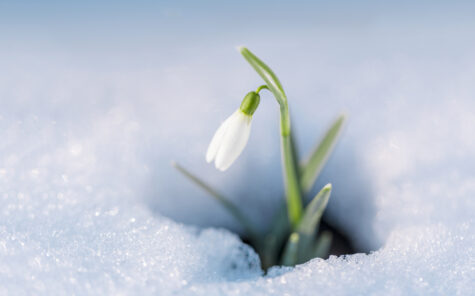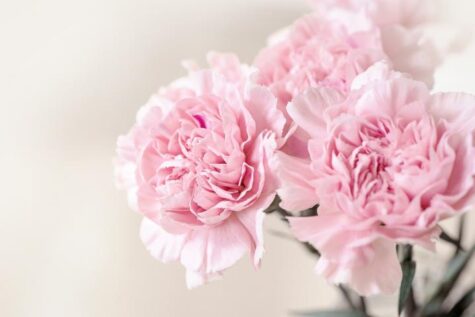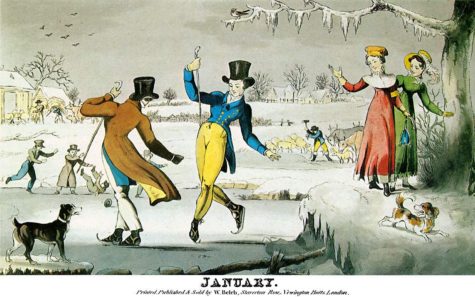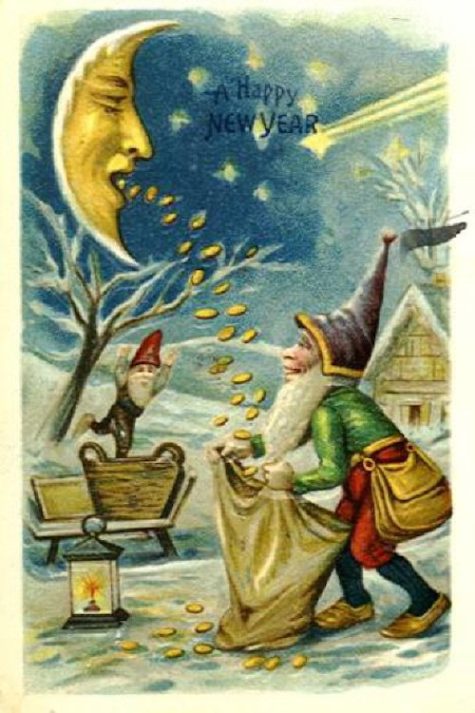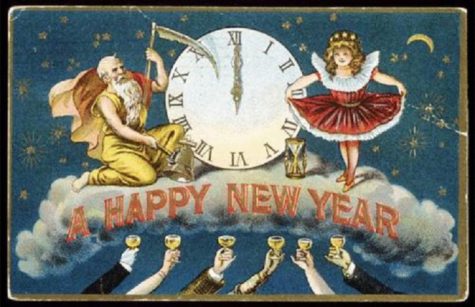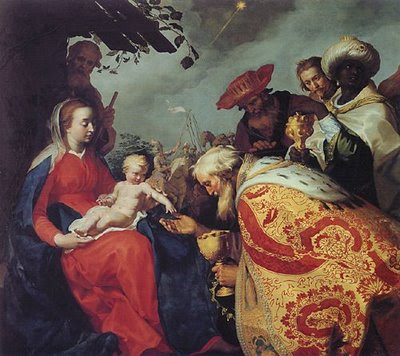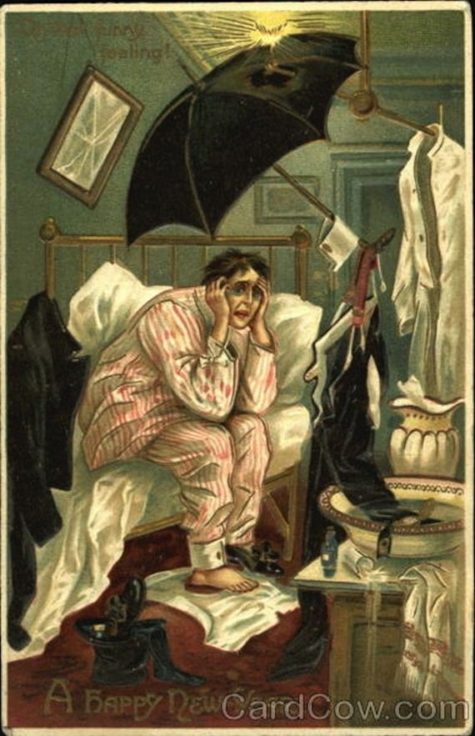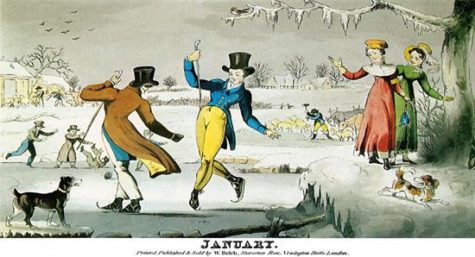January Lore
With winter setting in, those born in January have two birth flowers—the carnation and snowdrop. Whether they’re your “birth” flowers or not, these colorful flowers are sure to lift your spirits during these cold winter months.
Snowdrops
I’m not sure why Snowdrops are assigned to the month of January because these little flowers are also known as “Candlemas Bells”. February 2nd is Candlemas (Festival Day of Candles), and Imbolc. The ancient festival marks the midpoint of winter and some recognize it as the last day of the forty day Christmas season. In the catholic tradition, candles were brought into the church and blessed as a symbol of hope and light. In a time of no electric lights, candlelight offered great protection and comfort during the dark days of winter.
By producing their own heat, snowdrops actually melt the snow in their surroundings. Like candles, Snowdrops offer us our own light of hope in the grey of winter days. They are the emblems of friendship in adversity, harbingers of spring.
The first sight of snowdrops growing wild represents the passing of sorrow. In various religions, they are a sign from the gods that good times will come once more. According to one Christian tale, an angel turned falling snowflakes into flowers to give Adam and Eve a sign of hope after evicting them from the Garden of Eden.
The fact that snowdrops are often found, in abundance, in the old convent gardens, it was believed that this little white flower was sacred to virgins. For this reason, it was dedicated to the Virgin Mary. In some places, during the Candlemas celebration, it was customary for young women, wearing white gowns, to walk in procession carrying snowdrops in their hands.
It was often said that any one wearing a snowdrop would have only pure and lofty thoughts; and that if a young girl ate the first snowdrop she found in spring, neither sun nor wind would tan her that summer.
Carnations
Inhaling the gorgeous scent of the carnation flower will immediately enhance emotions of joy and happiness, so the addition of the essential oil is perfect for incenses and oils to dispel depression and disappointment. Brush flowers down your body to cleanse. After reaching the feet, break the stems to trap and hold the negative energy. This flower also helps relieve the depression of winter.
Keep red carnations on the altar to increase your energy level and to create more optimism in life. Once worn by Witches to prevent untimely death on the scaffold, it is used in power incenses and placed on the altar to produce added energy.
Dry nine red carnations in the Sun, crumble them and separate from the stems. Pour one dram carnation essential oil over them, mix well and smolder on charcoal for a tremendously powerful incense. Produces tons of energy!
Used to remove hexes and negative energy, the carnation is especially good for clearing out love problems. Add white and red carnations or essential oil to bathwater to stabilize your love life. Carnation flowers attract abundance as well, either as a bouquet or in a formula.
Including carnations or carnation oil in a blend for the sickroom is perfect to aid in the mental aspects of healing. If your eyes are bothered, rub them with red carnations – it will help. This belief comes from the biblical legend in which carnations sprang up where the Mother of Jesus’s tears fell as she cried over her son’s crucifixion.
Carnations have a history of being brewed into tea to help reduce stress and restore energy. Carnation tea has also been used to reduce fever and treat stomach aches. In addition to tea, carnation oil is used in beauty products to moisturize skin, minimize wrinkles, and treat skin conditions.
Source: Magickal Ingredients
The main theme for January is “CLEAN IT UP”.
We have some very big energies coming in that you will not be able to take advantage of if you are bogged down in physical, emotional and energetic clutter, old intentions, unfinished business, anything you have put off or procrastinated and should have done “yesterday”, regrets, unexpressed communication, attachments to disappointments and unmanifested dreams, persisting bad habits, and we can go on and on as the list is very long.
You cannot bring in the new without making space by cleaning out the old. It is very simple. We spend lots of time making new lists and talking about what we want to accomplish in 2019 but there is no room for anything new unless we declutter the past. If you clean up the past, you will have many more options about what and how to bring in some new dreams and experiences. And we have tremendous opportunity to do so.
Here is an image. You have an old roof that has been fixed and layered with new material many, many times. Now it is time for a new roof again as this one does not serve you. It is cracked and leaking. You can patch or put on another layer of roofing making the roof very heavy and requiring you to use the same material. Or you can completely remove the existing roof and start over giving you many options of what materials to use. Although it will take more time and energy up front, it will be something better and much improved and certainly much lighter.
The container of your life is like your roof. You can either layer it with the same old beliefs, judgments, intentions and habits, or you clean up the clutter and start over. Cleaning up requires courage to let go, to complete and to tie up loose ends. It may require you to release some old hopes and dreams. We need to recapitulate our sentimentality and make sure it is not getting in the way of creating something new. There are many layers and aspects of cleaning up and each of us will have different percentages of each one to do.
The year starts off with a set of eclipses potentiating any focused work we do this month. There is a pressurized quality to the month that motivates us to clean under the rug and dig deep to see what we actually have, what we want to keep, and what we need to clean up. You can find yourself busy these days with the inspiration to get that new roof on but it is important to do this in a structured and organized way. Otherwise the chaos (yes, it follows us into 2019) will have you distracted and focused in unimportant areas.
Physical Clean Up
This one is easy as it is very clear where the clutter is. Look with fresh eyes at what you surround yourself with and have the courage to get rid of things even if they are “still useful” but you have not actually used them in a long time. Be generous in passing them along to someone who may actually use them.
Papers, files, old photos, stuff your kids made, things people have given you, clothing equipment, electronics etc. If they do not have an active place in your life today, release them. Another category is unfinished projects that may have seemed like a good idea at one time but ask yourself if you are really going to ever get back and finish them. The attachment to all of these physical things is usually of the ego as they represent something connected to our identity; a success, relationship, time in our life, experience or event, recognition, education etc.
The artisan role of the year is a master of destruction. Use this artisan talent wisely in dismantling your current container so you can recreate it to serve you better. Take one aspect or section at a time and drawer by drawer, you will gain momentum in your process of clean up. There will be many parts you will keep, but they will end up being organized differently. To support this, you can start by making some changes in your schedule to accommodate the clean-up process.
Emotional Clean Up
This is an area that is usually somewhat messy as it has to do mostly with relationships, karma, betrayal, unrequited love, what was said, what wasn’t said, and lots of unfinished business and loose end especially around endings. Emotional confusion falls into this category as well. This includes not trusting your intuition or sitting on the fence about something and either not going after what you feel is right or not cutting something loose that looks right but isn’t, because you are too cautious to take the leap.
Feelings can be confusing especially when it comes to karmic agreements around relationships. When do you known when something is finished? And how do you know when something is right? The truth is, if it does not feel right or good, it probably isn’t and it is time to change the relationship. Sometimes, relationships need to simply change and not be banned forever. This is a great opportunity to clean up old relationships, even if just from your end, as well as to complete necessary communication. If someone has passed on before you got to say what you wanted to say, you can always write a letter to them and then burn it as an offering to clean the emotional energy.
Forgiveness is a big part of the emotional clean up and goes a long way to neutralize what has been charged with negative emotions. Practice forgiveness when possible especially with yourself as most judgment ends up being focused back inward in some way. It is time to release the attachment we have to suffering and low self-esteem. It will not get us through the pearly gates. Bottom line is that anything that has an emotional charge to it can use some clean up.
Energetic Clean Up
What are you still carrying for others? Where are your energy leaks?
The energetic clean up includes your belief systems and what you take on from others and how you allow the attention points and judgments of others to affect you energetically. This is often a subtle area to recognize but one that can profoundly affect you. Sometimes we do not know why we feel the way we do and what we feel makes no sense. This is probably due to an energy field that is cluttered with what is not yours.
This is an excellent month to learn how to differentiate between what is yours and what is not, and to set good boundaries.
On the other hand, when you hold your boundaries too close out of fear of losing control of your energy field, you are also not available for the power you could receive from all the greater sources of energy that support us, such as the elements, your essence, the energy of love, beauty, inspiration, wisdom, powerful times like the eclipses and moon cycles. Your allies, guides and spirit helpers and the ones that can connect you to those greater sources of energy. Cleaning up your energy and eliminating fear will open up communication and make room for these sources of greater power and energy.
According to astrological and lunar lore, there are best days for doing a variety of tasks. The best days listed here are based on both the phase of the moon and its position in the zodiac. Many people believe that if you do the tasks on the dates listed, you will get the best results possible.
January 1:
- Can Fruits and Vegetables
- Make Jams and Jellies
- Mow Grass (to slow growth)
- Plant Root Crops
- Plant Seed Beds
- Prune Trees
- Transplant (seedlings and plants)
January 2:
- Advertise Something for Sale
- Castrate Farm Animals
- Cut Hair (to slow growth)
- Demolition
- Harvest
- Kill Plant Pests
- Pick Apples and Pears
- Potty Train a Child
- Quit Smoking
- Start Diet (to lose weight)
- Wash Windows
- Wash Wooden Floors
- Wean a Baby or an Animal
January 3:
- Advertise Something for Sale
- Castrate Farm Animals
- Cut Hair (to slow growth)
- Demolition
- Harvest
- Kill Plant Pests
- Pick Apples and Pears
- Potty Train a Child
- Quit Smoking
- Start Diet (to lose weight)
- Wash Windows
- Wash Wooden Floors
- Wean a Baby or an Animal
January 4:
- Castrate Farm Animals
- Mow Grass (to slow growth)
- Plant Root Crops
- Potty Train a Child
- Prune Trees
- Wean a Baby or an Animal
January 5:
- Bake
- Castrate Farm Animals
- Cut Firewood
- Cut Hair (to increase growth)
- Dig Holes
- Mow Grass (to increase growth)
- Plant Above Ground Crops
- Potty Train a Child
- Wax Floors
- Wean a Baby or an Animal
January 6:
- Bake
- Castrate Farm Animals
- Cut Firewood
- Cut Hair (to increase growth)
- Dig Holes
- Mow Grass (to increase growth)
- Plant Above Ground Crops
- Potty Train a Child
- Wax Floors
- Wean a Baby or an Animal
January 7:
- Castrate Farm Animals
- Cut Firewood
- Dig Holes
- Kill Plant Pests
- Mow Grass (to increase growth)
- Paint
- Wean a Baby or an Animal
January 8:
- Castrate Farm Animals
- Cut Firewood
- Dig Holes
- Kill Plant Pests
- Mow Grass (to increase growth)
- Paint
- Potty Train a Child
- Wean a Baby or an Animal
January 9:
- Castrate Farm Animals
- Cut Firewood
- Cut Hair (to increase growth)
- Dig Holes
- Get Married
- Mow Grass (to increase growth)
- Plant Above Ground Crops
- Potty Train a Child
- Start Diet ((to gain weight))
- Wax Floors
- Wean a Baby or an Animal
January 10:
- Castrate Farm Animals
- Cut Firewood
- Cut Hair (to increase growth)
- Dig Holes
- Get Married
- Mow Grass (to increase growth)
- Plant Above Ground Crops
- Potty Train a Child
- Start Diet (to gain weight)
- Wax Floors
- Wean a Baby or an Animal
January 11:
- Castrate Farm Animals
- Cut Firewood
- Cut Hair (to increase growth)
- Dig Holes
- Get Married
- Mow Grass (to increase growth)
- Plant Above Ground Crops
- Potty Train a Child
- Start Diet (to gain weight)
- Wax Floors
- Wean a Baby or an Animal
January 12:
- Bake
- Cut Firewood
- Dig Holes
- Kill Plant Pests
- Mow Grass (to increase growth)
January 13:
- Bake
- Cut Firewood
- Dig Holes
- Kill Plant Pests
- Mow Grass (to increase growth)
January 14:
- Advertise Something for Sale
- Get Married
- Cut Firewood
- Cut Hair (to increase growth)
- Dig Holes
- Mow Grass (to increase growth)
- Paint
- Plant Above Ground Crops
- Wax Floors,
January 15:
- Advertise Something for Sale
- Cut Firewood
- Cut Hair (to increase growth)
- Dig Holes,
- Get Married
- Mow Grass (to increase growth)
- Paint
- Plant Above Ground Crops
- Wax Floors
January 16:
- Cut Firewood
- Dig Holes
- Kill Plant Pests
- Mow Grass (to increase growth)
- Set Eggs
- Travel (for pleasure)
January 17:
- Cut Firewood
- Dig Holes
- Kill Plant Pests
- Mow Grass (to increase growth)
- Set Eggs
- Travel (for pleasure)
January 18:
- Bake
- Cut Firewood
- Cut Hair (to increase growth)
- Dig Holes,
- Get Married
- Mow Grass (to increase growth)
- Plant Above Ground Crops
- Plant Flowers
- Plant Seed Beds
- Set Eggs
- Start Diet (to gain weight)
- Wax Floors,
January 19:
- Bake
- Cut Firewood
- Cut Hair (to increase growth)
- Dig Holes
- Get Married
- Mow Grass (to increase growth)
- Plant Above Ground Crops
- Plant Flowers
- Plant Seed Beds
- Start Diet (to gain weight)
- Wax Floors
January 20:
- Cut Firewood
- Dig Holes
- Get Married
- Kill Plant Pests
- Mow Grass (to increase growth)
- Paint
- Travel (for pleasure)
January 21:
- Ask For a Loan
- Cut Hair (to slow growth)
- Demolition
- Dig Holes
- Dig Post Holes
- Dry Fruits and Vegetables
- Kill Plant Pests
- Mow Grass (to slow growth)
- Paint
- Pick Apples and Pears
- Quit Smoking
- Start Diet (to lose weight)
- Wash Wooden Floors
January 22:
- Kill Plant Pests
- Mow Grass (to slow growth)
- Quit Smoking
- Slaughter
- Start Diet (to lose weight)
January 23:
- Kill Plant Pests
- Mow Grass (to slow growth)
- Quit Smoking
- Slaughter
- Start Diet (to lose weight)
January 24:
- Cut Hair (to slow growth)
- Mow Grass (to slow growth)
- Plant Flowers
- Plant Root Crops
January 25:
- Cut Hair (to slow growth)
- Mow Grass (to slow growth)
- Plant Flowers
- Plant Root Crops
January 26:
- Cut Hair (to slow growth)
- Mow Grass (to slow growth)
- Plant Flowers
- Plant Root Crops
- Set Eggs
January 27:
- Can Fruits and Vegetables
- Jams and Jellies
- Mow Grass (to slow growth)
- Prune Trees
- Plant Root Crops
- Plant Seed Beds
- Set Eggs
- Transplant (seedlings and plants)
January 28:
- Can Fruits and Vegetables
- Jams and Jellies
- Mow Grass (to slow growth)
- Plant Root Crops
- Plant Seed Beds
- Prune Trees
- Transplant (seedlings and plants)
January 29:
- Advertise Something for Sale
- Castrate Farm Animals
- Cut Hair (to slow growth)
- Demolition,
- Harvest
- Kill Plant Pests
- Mow Grass (to slow growth)
- Pick Apples and Pears
- Potty Train a Child
- Quit Smoking
- Start Diet (to lose weight)
- Wash Windows
- Wash Wooden Floors
- Wean a Baby or an Animal
January 30:
- Advertise Something for Sale
- Castrate Farm Animals
- Cut Hair (to slow growth)
- Demolition
- Harvest
- Kill Plant Pests
- Mow Grass (to slow growth)
- Pick Apples and Pears
- Potty Train a Child
- Quit Smoking
- Start Diet (to lose weight)
- Wash Windows
- Wash Wooden Floors
- Wean a Baby or an Animal
January 31:
- Castrate Farm Animals
- Mow Grass (to slow growth)
- Plant Root Crops
- Potty Train a Child
- Prune Trees
- Wean a Baby or an Animal
Source: The Farmer’s Almanac
The word January comes from the Roman name for this month; it was named after the god Janus who had two faces. This deity ruled over beginnings and endings, the past and future. Since January is reckoned as the first month of a new year, this connection with the god Janus is appropriate. It is an excellent time to work on putting aside the old and outdated in one’s personal life and making plans for new and better conditions.
Correspondences for January:
- Nature Spirits: gnomes, brownies
- Herbs: marjoram, holy thistle, nuts and cones
- Colors: brilliant white, blue-violet, black
- Flowers: snowdrop, crocus
- Scents: musk, mimosa
- Stones: garnet, onyx, jet, chrysoprase
- Trees: birch
- Animals: fox, coyote
- Birds: pheasant, blue jay
- Deities: Freyja, Inanna, Sarasvati, Hera, Ch’ang-O, Sinn
Power flow: sluggish; below the surface; A good time for spell work having to do with beginning and conceiving; protection; reversing spells; conserving energy by working on personal problems that involve no one else; getting your various bodies to work smoothly together for the same goals.
January Celebrations and Rituals:
The Chinese use the concept of putting aside the old and outdated in one’s personal life and making plans for new and better conditions in celebrating their New Year, which occurs on the first day of the New Moon when the Sun is in Aquarius. They considered this celebration a time for settling debts, honoring ancestors, and having family reunions. They carry paper images of dragons through the streets and set off fireworks to chase away evil entities and misfortune.
Tsao-Wang was the Chinese kitchen god or deity of the hearth and domestic comfort; his picture hung above the stove. He was the protector of the family and recorder of their actions and words. His report at the end of each year to the Heavenly Jade Emperor was said to determine the family’s coming fortune. Because of this, the Chinese burned the old picture-image and put up a new one a few days before New Year. His wife had the task of reporting on female family members.
Even the people of Tibet, whose year began about the end of January, had a celebration for expelling the Old Year. They made a dough image for the demons to inhabit, then worshiped them for seven days. At the end of that period, they took the image outside the village to a crossroad and abandoned it. The idea behind this seems to have been that the negative beings who had accumulated during the Old Year, received recognition for their existence, but also received a firm statement, by the action of leaving their image outside the village, that they were not welcome to hang around.
Most cultures had some ceremony for ending an old cycle of the calendar and celebrating the beginning of a new cycle. Physical activity acknowledging the end and beginning of cycles sets off similar changes in the subconscious mind. This change in the subconscious is necessary in order for actual physical changes to come about. Such rituals are helpful when one faces the end of cycles in relationships, career, residence, or other life situations.During the Feast of Kore, which was held at night with much feasting and dramatics, a group of initiates bearing torches went down into the goddess’s underground chamber. With much ceremony and reverence, they brought out the wooden statue of Kore, naked except for her golden jewelry. The statue was placed on a decorated litter and carried seven times around the temple. The Greeks considered that the number seven brought luck and success.
The Incan festival of Camay Quilla was held at the New Moon.
The Seven Deities of Luck in Japan were honored during a three-day festival called San-ga-nichi. To avoid good luck being swept away, there was no sweeping during this festival. These Seven Deities are also called Shichi Fukujin or Shichi-Kukujin, which means “Seven Gods of Happiness.” There are six gods and one goddess that make up this little group. They sail about in a treasure ship called a takarabune.
A branch of the plum-tree placed over the door at New Year’s is very luck bringing, as the tree is so beautiful and fruitful.
The orange is placed over the door in Japan on New Year’s day so that the family shall continue perpetually, and generation after generation shall follow each other like the buds, flowers, and fruit.
Cook cabbage on New Year’s day and you will have good luck all the year.
Decorated apples stuck on three skewers are exchanged for luck on New Year’s day in Great Britain.
It is lucky to have the last glass from the last bottle of wine on New Year’s.
At Bromyard, England, at midnight, December 31st, a rush is made to the nearest well or spring of water, and he who gets the first drink of it, “the cream of the well,” will have fine luck all the coming year.
The last glass of wine or spirits drained on New Year’s eve is called the “Lucky Glass,” and whoever is fortunate enough to get it, will be successful during the coming year.
In Japan oranges are hung up on New Year’s day as a charm to insure the long life of the family.
Just before midnight on New Year’s eve, the Chinese put on new or clean garments so as to enter the new year purely, and thus gain good fortune to themselves.
On New Year’s eve at Biggar, Lanarkshire, a large bonfire of thornbush is lit and kept burning all night, and the boys jump over it for luck during the year.
A present of money given in China at the end of the old year is an auspicious omen for the new year.
Money presents from members of a household to each other are strung on a red string as a symbol of joy.
New Year’s night quiet and clear indicates a prosperous year.
The Chinese think New Year’s day is the luckiest of the year.
If you leave a glass of wine standing between eleven and twelve on New Year’s night, and it runs over, the vintage will be good that year.
The Chinese say that if a man sits up for ten years in succession and sees the New Year come in, that he will have a very long life.
It is lucky to rise early on New Year’s morning.
If a person receives money on New Year’s day, it is a good omen, for they say that he or she will continue to do so all the year.
If the first carol singer who comes to the door on New Year’s morning, is brought in at the front door, taken all through the house, and let out at the back door, it will bring luck to the house for a year.
The Europeans as well as the Japanese hang the “lucky bag,” a square of white paper tied with a red and white string, over their gates on New Year’s day for luck.
If you put a coin into the spout of a pump on New Year’s eve, and bring it into the house the instant the clock has struck twelve, you will have a prosperous year.
The Germans have a superstition that if you serve “Hopping John” (peas and rice boiled together) at dinner on New Year’s day, you will be lucky all the year.
In China a small white cock is killed on New Year’s day, to bring good luck for the coming year.
It brings good luck to place a piece of money on the window on New Year’s eve.
A triangular cake, filled with mince meat, was formerly baked, and bits of it fed on New Year’s day to the cattle in Coventry, England, for good luck.
It is said to bring good luck through the year if you place a diamond, or a gold or silver coin, in a glass of water and drink of the water the first drink you take on New Year’s morning.
Feed the birds well on New Year’s morning by placing a sheaf of wheat or barley or some bread outside your house, then good luck will attend you, and good crops and prosperity come to you during the whole year.
To have peas for dinner on New Year’s day is said to bring money all the year.
The inhabitants of Heligoland have a custom on New Year’s eve to perambulate the streets with broken pots and pans which they place before their friends’ doors, and the man who has the largest heap is the luckiest and most popular.
For fishermen to draw blood with hook or gun on New Year’s morning is to insure a plentiful year.
It is considered good luck in England to sand the steps on New Year’s day.
On New Year’s eve the Chinese tie small gourds around the children’s necks as a safe-guard against the small pox. Some Chinese put paper masks on their children on New Year’s eve, believing that the small-pox god will pass them by, and not recognize them.
In Germany it is said that the person who eats millet and herring on New Year’s day, will never be wanting of money during the year. Others eat seven or eight kinds of cake, one of them made of powdered poppy seed mixed with flour and water, in order to insure prosperity during the new year.
In the neighborhood of Gorlitz and in the Ukermark, on New Year’s eve, straw bands are placed under the table and the guests rest their feet upon them; and afterwards they are taken out into the orchard and bound around the trees, so that they will bear well the next year. (German.)
In Turkey, on New Year’s Day, every stranger entering the house must throw salt on the fire for luck.
At midnight on New Year’s eve the Japanese father dressed in his richest attire sword in hand or sabre in his girdle, and with a box of roasted beans in his left hand, goes alone all through the house with his right hand scattering the wonderful beans around, saying: “Avaunt demons! Begone devils! Enter Fortune! Come in Prosperity!” This causes the evil spirits to leave.
The teacher in China who must send poems on New Year’s day to the parents of his pupils, sits on New Year’s eve writing them with a dish of rice and a vase of flowers before him on the table, these offerings to the sun causing him to write better rhymes.
To receive a letter containing good news on New Year’s day, is a sign of good news coming all the year.
“He who is born on New-Year’s morn
Will have his own way as sure as you’re born.”
In one locality in England, bands of straw were put under the feet on New Year’s day while at table. When the meal was finished, one person got under the table and another one sat on his back and drew out the bands of straw. These were taken to the orchard and bound around trees, which were thereby insured to bear a full crop of fruit the next year.
Place a gold coin on the threshold when you lock your door on New Year’s eve and take it off in the morning when the Church bell rings; you will then have money to spend all the year.
On New Year’s day cakes called “Poplady” were eaten for luck. They rudely resembled the human figure with two dried currants or raisins for eyes, and another to represent the mouth; the lower part being formed somewhat like the case of an Egyptian mummy. This cake is no doubt a relic of Egyptian or Roman superstition.
New Year’s night is celebrated in Hungary, the same as in most other countries, by much shouting and boisterousness generally. This is kept up all night, until daylight; to scare bad luck and evil spirits away, they say.
Source: Encyclopaedia of Superstitions, Folklore, and the Occult Sciences of the World
In Madagascar New Year’s is celebrated with much feasting and sacrificial killing of oxen takes place.
Chinese custom requires that every boy who calls on his neighbors or relatives on New Year’s day, should receive a couple of loose-skinned oranges, or he is considered shamefully treated. The name of orange means luck, fortune, and auspiciousness.
On New Year’s eve while the clock is striking twelve, repeat three times: “Good Saint Anne, good Saint Anne, send me a man as fast as you can,” and you will become engaged within a year.
At the beginning of the New Year in Natal, a ceremony is performed by the chief by spurting from his mouth a mixture of the New Year’s fruits in different directions as if upon his enemies. After this ceremony it is lawful for the people to eat the New Year’s fruits. They are only eaten by stealth before.
It was a custom of the Jews to serve up sheep’s head on New Year’s at their chief entertainment, as a mystical representation of the ram offered in sacrifice for Isaac. When a family or company sat down to this repast, each person took a piece of bread and dipping it in honey, said, “May this year be sweet and fruitful.”
In several parts of Belgium it is customary for the people to make waffles on New Year’s day. Around Liege the first waffle is crossformed or cut cross-wise, and placed on the chimney-piece as a New Year’s gift to the crucifix. It is believed that this waffle or cake is blessed; it does not rot and a small piece given to a sick man or beast makes them recover.
An old New Year’s custom which is still observed in some of the northern counties of England, is called “Going about with a vessel cup.” Poor women and girls desirous of obtaining charity take two dolls, representing the Virgin Mother and Infant Jesus, and go about from house to house during the week before New Year’s singing a quaint old carol and at its conclusion presenting for the receipt of alms a small cup, which is known as a “vessel cup.” To turn one of these vessel cup singers unrequited from your door is to forfeit all good health and good fortune for the approaching new year.
In Westmoreland and Cumberland early in the morning of New Year’s the “Taex Populi” assemble carrying stangs (long poles) and baskets. Every inhabitant or stranger who falls into the hands of this ruffian band will be sacrificed to their favorite Saint; a man is mounted on a stang, a woman is basketed, and carried shoulder high to the nearest balance and weighed. None are allowed to follow their accustomed occupations on this day.
In Guria in Asiatic Russia, the New Year is prepared for a month before the time comes; the people pen up poultry, turkeys, ducks and geese; but the chief animal for food is the pig which is fatted up a month before and killed two or three days before New Year’s. Continue reading
“Twelfth-day” is the twelfth day after Christmas, or Epiphany, occurring on the 6th of January. It is a festival of the Christian church in commemoration of the manifestation of Christ by the star which guided the magi to Bethlehem. “Twelfth-night” is the eve of Epiphany, when many social festivities and superstitious rites were observed. “Twelfth-tide” is the time or festival of twelfth-day. “The Twelfths” are the twelve days between Christmas and Epiphany. Epiphany is also called “Little Christmas,” being the social festival which brings the merry-makings of the Christmas cycle to an end.
A special cake, called “Twelfthcake,” is prepared for the festivities on twelfth-night. A bean or a coin is baked into it, and, the cake being divided by lot, whoever draws the slice containing it is entitled to preside as king or queen over the festivities. This custom is a relic of the old Roman festival of the Saturnalia, at the close of which the Roman children drew lots with beans to see who would be king.
A series of cards, called “Twelfth-night cards,” representing different characters such as king, queen, minister, maids of honor, or ludicrous or grotesque personages, were distributed among the guests, who had to assume the respective characters during the festivities.
A curious custom is the annual cutting of the Baddeley cake at Drury Lane Theater, London, on Twelfth-night. William Baddeley, the last actor to wear the uniform of “His Majesty’s Servants,” left £100 in bank stock, the income from which was to buy a Twelfthcake, with wine and punch, which the ladies and gentlemen were requested “to partake on every Twelfth-night in the great greenroom.”
The Devonshire farmers have an old custom of wassailing the fruit trees on the eve of Twelfth-day. They proceed with their servants, who carry large pitchers or milk pails filled with cider, to their orchards. Here one tree is selected as representative of the rest, and saluted with certain incantations; cakes are dipped in the cider and hung up on the branches, and the tree is sprinkled with the cider. They all dance merrily around it and afterward return home to feast. This is done in order that the trees should bear more fruit.
“Wassail the trees that they may bear
You many a plum and many a pear;
For more or less fruits they will bring
As you do give them wassailing.”
On twelfth-day in Ireland, they set up a sieve of oats as high as they can and in it a dozen candles. In the center is a larger one, all lighted, so as to have luck all the year.
In Styria, Austria, Epiphany is commonly called St. Bertha’s day, and it is believed that the devil is abroad in great force on that St. Bertha’s night. If one makes on that night a magic circle, and stands therein holding elder-berries gathered on St. John’s night, one would obtain the magic fern-seed which will come wrapped in a chalice cloth, and confer on one the strength of thirty or forty men.
On Epiphany, or as it is called in Bohemia, “Three Kings’ Day,” the festival of the three wise men who visited the Infant Saviour, three crosses should be made on every door, not only of the house but on the stables, pens and coops, to keep witches away. Bonfires are made at night and brooms are thrown as high as possible, all on fire, to represent the burning and the scattering of the witches. But beware that you do not point at one of the flying brooms! One of the fiery darts will pierce your finger.
When Queen Elizabeth visited Sudely Castle, Gloucestershire, about 300 years ago, on twelfthnight, “drawing the bean and pea” took place in her presence. No reason is given for the introduction of the bean and pea into the twelfth-cake, but Brand takes us to the ancient Greeks for the bean, and it may have been used on account of its mystic meaning. It was not allowed to be used for food by any of the disciples of Pythagoras lest it should be a receptacle of a departed soul, to eat which would be as impious as eating human flesh.
In Macedonia, on the 6th of January, which commemorates the baptism of Jesus Christ, a cross is thrown into the river by the priests and dived for by the men. Sick children are dipped into the water for healing. Some of this holy water, which is considered to have medicinal value, is carried home by the people, and health is insured to all who wash in it. In Kavadartsy, some of this water is used to make new leaven for the bread, and some is also thrown into the well. In Monastir straw dipped into this holy water, is wrapped around the trunks of trees to make them fruitful.
On the eve of Epiphany, the Albanians also roll a round cake to the middle of the vineyard, and then distribute it in bits for the ravens, crows, and other birds, saying: “Assemble, oh ravens, oh crows, and eat, so that we may eat and drink and you do us no harm.” This will so appeal to the honor of the birds that they will not touch the vines.
In Bohemia, the inscription “three kings” is made upon the door of the chief room of the house from the inside, every year on the 6th of January, “Three Kings’ Day” by the priest, teacher, or sexton of the town, with a blessed crayon or chalk, in the form of C x M x B x 1899 (or whatever year it may be), which means the names of Caspar, Melchior, and Balthasar, the three wise men who paid court to the Infant Jesus. This inscription protects the house from evil spirits and prevents them entering the rooms. It also brings blessings to the inhabitants. This we find of course only in Catholic families, and none of their domiciles are without it. The priest blesses the chalk for the believers, that they make inscriptions also upon the doors of their stables and barns to repel all witchcraft and magic that might do harm to the cattle or crops.
More Epiphany and Twelfth Night Lore:
- Brooms bound during the twelfths protect against witchcraft.
- Do no threshing in the twelfths, or all the corn within hearing will be spoiled.
- If cattle are fed with stolen kale (a kind of cabbage) during the twelfths, they will come to no harm.
- Whatever is dreamed during the twelfths will come to pass in the twelve months of the year.
- If a broken arm is bound five or six times round with thread spun in the twelfths, it will speedily become sound.
- In the twelfths magpies should be shot and burnt to a powder, which is good for the ague.
- Those who wear linen made from yarn spun during the twelfths will be devoured by wolves.
- No moth will come into yarn spun during the twelfths.
- If hens are fattened with peas during the twelfths, they will lay many eggs.
- At twelfth day the days are lengthened a cock’s stride.
- In the country between Hamelin and Mindcn and in other places, it is believed that no dung should be taken out of the cow house during the twelfths, else the cattle will be sick the following year.
- He who steals on twelfth-night, can steal safely for a year.
- If you eat peas or beans on twelfth-night, you will fall sick.
- On the twelfth-night the dead walk, and on every tile of the house a soul is sitting waiting for your prayers to take it out of Purgatory.
- If in the twelve-nights neither master nor man bring fresh-blackened shoes into the stables, the cattle will be bewitched.
- On twelfth-night in Scotland a board is covered with cow’s dung, candles set in it, and sprinkled with ash to make them light easily. They are then lighted, each being named for someone present, and as each dies, so will the life of the owner.
- In the “Book of Precedents,” published in London in 1616, we read that the 6th of January was five times lucky for Charles, Duke of Anjou, and equally lucky for the Earl of Sunderland.
- If a Danish girl wishes to see her future husband, she must repeat the following verse before going to bed on the eve of Epiphany: “Ye three holy kings to you I pray, That ye to-night will let me see, Whose cloth I shall spread, Whose bed I shall make, Whose name I shall bear, Whose bride I shall be.”
- Be sure for luck’s sake to spin off all the distaffs on the morrow after twelfth-day.
- The twelve days after Christmas make the almanac for the year.
- Tis thus believed in Trinity Bay, New Bedford, Mass., and Nova Scotia. In Nova Scotia it is said that the first seven days of January foretell the first seven months of the year.
- Those who do not spin in the twelfths may not wind on the 13th. (North Germany)
- In Transylvania whoever dies on the feast of Epiphany, is considered lucky.
- On the eve of Epiphany, the Albanians sprinkle the grapevines with holy water, believing that this will induce them to bear well.
Found in:
Encyclopaedia of Superstitions, Folklore, and the Occult Sciences of the World
There is a lot of lore and superstition surrounding the New Year. What follows is an extensive listing of what NOT to do, and what to avoid at all costs on this most powerful day of the year:
- New Year’s day was one of ill omen to the ancient Egyptians.
- It is unlucky to have clothes hanging on the line when the New Year is born.
- If a person in deep mourning pays you a call on New Year’s day, a member of your family will die before the year is out.
- In Northern Yorkshire, people will not allow anyone to light a candle from the fire on New Year’s day, so afraid are they to “carry fire to fire.”
- The Chinese believe a Buddhist priest to be the first to enter a house on New Year’s morning is even worse than to have a woman first enter it.
- Burn all the visiting cards that have been received throughout the year on the first of January. If you keep them from year to year you will have bad luck.
- If you have not provided yourself with a calendar before the New Year comes in, you will be behindhand in all your undertakings during the year. (Massachusetts.)
- If you eat apples on New Year’s day it will produce abcesses.
- Some people believe that if you put on clean linen on New Year’s day, you will have sores come on your skin.
- On New Year’s day no one must utter the words that indicate death in any form, especially the word “shi” itself, lest the invitation be accepted. (Chinese.)
- The Chinese believe it very bad luck not to pay all of his outstanding accounts on the last day of the year, and begin fresh and straight on New Year’s day.
- If a creditor makes a disturbance in the house of a debtor on New Year’s Day it is considered a most unlucky omen for the future prosperity of the debtor. (China.)
- It is bad luck in China to spend money the first three days of the year, except for candies and refreshments.
- If one sneezes on New Year’s eve while preparing for bed, it is a sign of misfortune during the coming year. (China.)
- It is a sure sign of strife and debates among the learned, and of many robberies to happen during the year, if the new year is ushered in with very red clouds.
- A corpse in the house on New Year’s day is the sign of another death to follow soon.
- The throwing of coal-dust or soot instead of lime before a door on New Year’s day, betokens gloom and bad luck. (Malta.)
- When the wind blows on New Year’s night, it is a sign of pestilence.
- “If you wash clothes on New-Year’s day, you’ll be sure to wash a friend away.”
- It is unlucky to sow on New Year’s day.
- Spend on New Year, spend all the year.
- It is very unlucky to refuse a beggar anything on New Year’s day, or to refuse a request of any kind.
- A sudden noise on New Year’s night foretells the death of an inmate.
- To meet a priest before any other male on New Year’s day, is a sign of death during the year; if a policeman, litigation is sure to follow.
- It is unlucky to have a flat-footed person enter the house first of any one on New Year’s day. (Folk Lore of Northern Countries.)
- It is an omen of ill luck if a redhaired woman enters a house on New Year’s morning.
- If the first man you speak to on New Year’s morning has his hands in his pockets, you will have a hard time getting what money you want during the year.
- Among the Highlanders, if a black and threatening cloud appears on New Year’s eve, it is looked upon as a forerunner of some dire calamity to the country or to the family estate over which it appears to hang.
- French flax is put on the spindle New Year’s eve in many parts of Germany. None must be spun then, as it would be bad for the year’s spinning.
- It is unlucky to have the fire go out on New Year’s day.
- It is unlucky to eat anything green on New Year’s day.
- In Hesna, it is unlucky to eat an apple on New Year’s day.
- In the rural districts of Cornwall, it is unlucky, if a female is the first to enter a house on New Year’s morning.
- In some of the northern countries of Scotland, it is considered unlucky to enter a person’s house on New Year’s day empty.
- In Scotland, nothing that could be washed on the last night of the year was left unclean. Even the walls were whitewashed inside, lest misfortune should fall upon the family.
- To break a white lamp-globe on New Year’s day is a sure sign that you will experience great financial losses during the year.
- To break a colored lamp-globe on New Year’s day is a sign of the death of a near relative during the year.
- The Chinese think it unlucky to allude to any possible misfortune on New Year’s day.
- It is unlucky to take ashes out of the house on New Year’s day.
And last but not least:
In Malta, a superstitious dread still attaches to some one of the family keeping absent at dinner time on New Year’s day. He who doesn’t dine with his family on New Year’s day is expected to die at the end of that same year. It is also said in Malta that he who eats hotch-potch soup on New Year’s day is to gnaw the ham bones all the rest of the year; and that those who eat cabbage on New Year’s day will groan for a whole year.
January starts the year with a plethora of fun, frolicsome festivity. The new year in particular is celebrated by at least 170 nations. In terms of energy, January focuses on beginnings. It’s a time for personal renewal, starting any beloved project, and sustaining those things already in progress.Magic for health, protection, and prosperity is particularly augmented by working during this month. It’s also good time for spell work having to do with beginning and conceiving; protection; reversing spells; conserving energy by working on personal problems that involve no one else; getting your various bodies to work smoothly together for the same goals.
Weather Watching:
It is said that whatever the weather is like the first twelve days of January indicates what the weather will be like for the next twelve months. Each day equals one month in succession.
January Birth Signs
(Celtic, Nordic, Astrological, etc)
- Dec 22 to Jan19 – Sun in Capricorn
- Dec 22 to Jan 21 – Sign of the Carnation Flower
- Dec 23 to Jan 1 – Sign of the Apple Tree
- Dec 24 – Jan 21 – Sign of the Birch Tree
- Jan 1 to Jan 11 – Sign of the Fir Tree
- Jan 12 to Jan 24 – Sign of the Elm Tree
- Jan 21 and Feb 19 – Sign of the Orchid Flower
- Jan 21 to Feb 19 – Sun in Aquarius
- Jan 21 – Feb 17 – Sign of the Rowan Tree
- Jan 25 to Feb 3 – Sign of the Cypress Tree
January – the month of new beginnings. January was introduced into the Roman calendar by a legendary king of Rome, Numa Pompilius (c. 715 – 673 BCE), who named it in honor of Janus, the god of doors and openings, beginnings and endings.
Since January is reckoned as the first month of a new year, this connection with the god Janus is appropriate. It is an excellent time to work on putting aside the old and outdated in one’s personal life and making plans for new and better conditions.
 Tonight is the night of the Wolf Moon. This first full moon of the new year is a time of silence and sitting by the home fire. As the wild winter howls, appreciate the warmth of home and family.
Tonight is the night of the Wolf Moon. This first full moon of the new year is a time of silence and sitting by the home fire. As the wild winter howls, appreciate the warmth of home and family.
Now is the time to go within and plan the changes you will make in the spring. Consider now what you will plant. Start a moon journal to record your lunar tides and write down your spring dreams.
Correspondences:
- Colors: Black and white, silver
- Gemstones: Hematite
- Trees: Birch, Hazel
- Gods: Inanna, Freyja
- Herbs: Thistle, nuts and seeds, marjoram
- Element: Air
Full Moon names started with Native Americans as tribes kept track of the seasons by giving distinctive names to each recurring full Moon. The names actually applied to the entire month in which each occurred. There was some variation in the names based on tribes. European settlers followed that custom and created some of their own names.
Sometimes it is also referred to as the Cold Moon, Old Moon, or the Moon After Yule. Some called it the Full Snow Moon, but Wolf Moon seems most appropriate, in native cultures, because amid the cold and deep snows of midwinter, the wolf packs howled hungrily outside their small villages, huts, and teepees. Since the lunar month is only 29 days long on the average, the full Moon dates shift from year to year.
This is a good time to work on magic related to protection, both physical and spiritual. Use this time to develop your inner self, and advance spiritually, becoming closer to the higher aspects of your deities.
More about the Full Wolf Moon
It’s been a tough month for some of us. I thought it fitting to toss out some symbolic observations about the January Wolf Moon with a goal to offer inspiration to folks facing some challenges right now.
- Lunar Symbolism:
Before blasting off into Wolf Moon symbolism, let’s take a look at lunar implications. Subtle, cunning and soft in silky shadows, the moons meanings can be slippery. But, to those who grasp moon symbolism, great insights follow. Typically feminine in archetypal understanding, the moon carries themes of cycles and fertility.
Moreover, the moon conveys a kind of creativity that is born from veiled magic. Consider the moon’s growth cycles (waxing, full, waning, new). These phases are wrought from the moon’s movement. And, the manifestation of her development is made known to us through light and shadow.
What’s the symbolic lesson here? Progress is sometimes subtle. Manifestations of evolution often occur behind the scenes, in shadow – before we “see the light” or the end-product of our vision.
When contemplating this month’s full moon and its partnership with the Wolf, we must not cram our intellect into the void. Rather, the Wolf Moon asks us to use intuitive instinct in soft ways.
The gifts of this full moon come to our senses like steam rising over sacred waters marbled with frosty stillness.
Wolf Symbolism and Wolf Moon Solutions:
Strategic, resourceful and incredibly communicative, the Wolf is a noble mentor for humankind. Wolves have specific protocol and rank within their packs. This observation is a cue to look to community for creative solutions during this full moon. Communicate with those in your pack to help you with your challenges. But don’t break taboo. If you follow specific traditions in social communication, hold to them. In fact, use this full moon to honor traditions of your heritage. Take time to honor your elders too. Tribal rituals should be heeded this time of year.
Wolves are vastly expressive. Sure, their vocalizations (baling, howling and barking) are legendary, but Wolves also have an complex system of body language and even eye contact to convey intent and current state of being. Discipline in the pack is rarely corporeal. Rather, behavior is admonished or reinforced by intricate expressions. One look from the Alpha can convey as much power as a physical blow.
There’s big medicine in this. Use this full moon to get in touch with your own modes of expression. Explore your own eye contact and body language. Examine yourself in the mirror (yes, I’m serious) as you’re talking on the phone. View yourself objectively. What are your expressions conveying? How can you modify or enhance your body language to portray more authority or power? Or, perhaps more softness and sensuality is needed. Too often we are unconscious about our eye and body movements in the scheme of social interaction. This is a great time to ponder these nuances of communication.
Wolves are also phenomenally resourceful. In fact, their resourcefulness is partly why this moon carries the Wolf moniker. January is a brutal month in the northern regions. The frigidity of winter crunches life to a stand-still in the wild. To be sure, it’s a time of “sink or swim” to all wildlife exposed to the elements this time of year.
Wolves, however, often thrive during this lean month. They are designed to handle the brutality of cold quite well. Furthermore, as Wolves are inclined to pick off weaker animals, January offers up a host of feasting options. Perhaps we can use the resourcefulness of the Wolf to reconsider our options in life. Maybe what seems bleak or lame in our life is actually an invitation for opportunity. Food for thought.
I hope these symbolic ideas about the cold Wolf Moon inspire you to take advantage of January’s lunar fullness. Take a pause on the evening of this month’s full moon to contemplate your own inner wisdom too. I bet your findings will be illuminating.
~collected from various sources, including Symbolic Meanings
